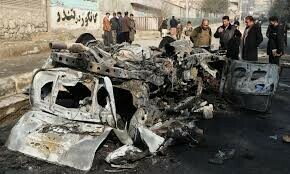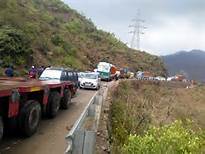How Security Forces Eliminated the Entire Militant Leadership in Kashmir
For the first time in four years, more militants have been killed than those who have joined terror groups, Jammu and Kashmir DGP Dilbagh Singh has told News18.
Speaking about the recent successes in counter-insurgency operations, including elimination of Hizbul Mujahideen commander Riyaz Naikoo and the foiling of a repeat of 2019 Pulwama style IED attack, Singh said the current year was turning out to be one of the most successful for the forces in recent years.
“This is not a job that was done in a month or two. For the past two to three years we have put in a concerted effort. It was in the second half of 2018 that we began to firmly tilt the scales in our favour. We strengthened our intel network and improved coordination,” Singh said.
Within this year alone 119 militants have been killed, including operational commanders Riyaz Naikoo, Abdul Rehman alias Fauji Bhai, Zubair, Qari Yasir, Junaid Sehri, Burhan Koka, Haider and Tayab Walid. This has broken the back of terror groups in the valley.
Not only have the security agencies, led by J&K police, been able to eliminate the top leadership of the terror groups, they have been able to do it with minimum loss to their own men.
According to data available with South Asia Terrorism Portal (SATP), 12 civilians and 29 security forces have died in clashes this year, which is a testament to an improved law and order situation as well.
If one compares the ratio of security force personnel killed to the number of militants eliminated over the past four years, in 2017 it was almost slightly better than 1:3. In 2018 it was almost 1:3, in 2019 it worsened to almost 1:2. So far, this year, the ratio has improved to 1:4. In other words, four militants are being killed for the loss of every security force personnel.
“It’s a healthy trend. On the law and order front also, 2020 is turning out to be one of the best in recent years. Number of violent clashes have come down by 20 per cent over previous years,” Singh added.
Giving the example of the handling of law and order situation after killing of top Hibzul commander Riyaz Naikoo, he said no one was allowed to assemble and attack police posts. Same was the case after the deaths of Zakir Musa and Junaid Sehrai.
“Incident to incident we have been quite successful in containing the situation. We see to it that our response, in keeping violence to a minimum, is much more than what the situation demands,” Singh added.
Many within the forces attribute the success in the counter-insurgency operations to two factors. The first is the police’s greater involvement in not just providing the information but in executing the encounters as well. The second is the lockdown that has prevented militants from moving about freely within the valley and being traced down easily.
“Our input generation was the best always but we are getting better every day. There is a remarkable cohesion right from DGP to the level of an SHO. The chain of command is clear and there is no confusion. Over the past few months we started working specifically on the top terror commanders as a project. It was a long process of combining human and technical inputs but it has paid off very well,” said a senior police officer on condition of anonymity.
“Now you look at any terror organisation…it is completely leaderless. Whether it is Hizb, Lashkar, Ansar…we have not only eliminated their top leadership but the possible second rung as well. They are clueless and frustrated,” the officer added, adding that the quality of intel is top notch.
“This is how we were able to trace the car in which militants had planted 40 kilos of explosives despite them having fabricated the registration number. We had the advanced inputs about that car down to the last scratch,” he added.
The senior officer who has been part of many successful counter-insurgency operations said that minimising loss of civilian lives was a top priority for the forces. “Take the encounter in Srinagar two days ago. It was 100 per cent a police operation. Or take the encounter in Awantipora, in which terrorists were holed up in a mosque. We did our job keeping in mind the religious sensibilities so that the holed-up terrorists were killed without causing any sort of damage to the mosque. The public notices how sensitive we are with them. It helps expand our reach,” he added.
Tahir Ashraf, SP, Cyber police, said that police was taking all measures to give a chance to those who had joined terror groups to surrender. “In the recent Srinagar encounter case, a family contacted us claiming that one of the holed-up terrorists was their son. We did everything we could…got the parents to come there and make an appeal to their son to peacefully surrender arms, but he lobbed instead opened fire at us, so at the end we were left with no choice but to eliminate him,” he said.
Former J&K DGP Kuldeep Khoda said that active monitoring of social media may also have helped police in reaching out to those who were potential fodder for terror groups, and preventing them from taking guns in their hands.
“Success of forces depends on several things. Synergy between forces, avoiding one-upmanship, development of technical and human intelligence, on all these fronts the police has done a great job. But what the police has also done recently is proactively track social media, which people like Burhan Wani had exploited to their advantage,” said Khoda.
Paul Nathanael, former CRPF Inspector General, who has served in Kashmir, argues that lockdown and curbs on the internet have helped counter-insurgency operations to a great extent.
“Earlier we used to get news about informers being killed regularly. That sort of thing isn’t happening anymore. Because now information is being shared securely and discreetly. Secondly lockdown prevents easy movement of terrorists, prevents them from mingling in the crowd. Therefore, any move they make instantly gets registered in the security grid.”
Another senior police officer, who wished not to be named, gave the example of the police’s handling of the situation after the killing of Riyaz Naikoo, as an example of the grip police has been able to establish in the valley.
“For four days we had stationed our men outside his house to prevent crowds from gathering. It usually happens that a new cycle of violence starts with people who attend funerals of militants. In this high-profile case we were able to prevent any such gathering. Not one major instance of violence was reported in days following it,” he said.
However, despite the best efforts of the police, some challenges still remain. At a time of increased vigil on the border, terror group chiefs from the other side are trying desperately to find new means to smuggle guns into the valley. Three days ago BSF shot down a drone 250 meters inside Indian territory, which was carrying sophisticated weapons including assault rifles and explosives.
Those like Khoda, who have led the police force, advocate taking decisive “proactive action across the border”, such as India took through air strikes in Balakot last year.
The other challenge is to gradually dismantle all support and sympathy for Pakistan-based terror groups in the valley, after all the active and dormant militants have been taken out, the ground for which police is laying right now. This would be the round two of counter-insurgency operations, one that would need more time and sustained efforts.
News 18






